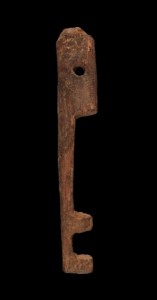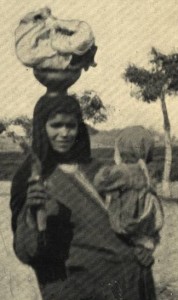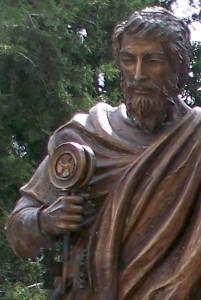In my research on the Song of Songs, I have come across numerous authors—mainly commentators on the Song—who contend that Theodore of Mopsuestia (c. 350-428) was condemned by the Second Council of Constantinople for his views on the Song of Songs. Theodore was an important theologian and his writings were often cited by the Nestorians in support of their views.
Here are some examples of Bible scholars mentioning the case of Theodore:
“Theodore of Mopsuestia (ca. 350-428 CE) saw the Song as love poetry composed by Solomon to justify his marriage to the daughter of Pharaoh (1 Kgs 11:1) and concluded that it should not be in the canon. He was posthumously condemned for his views on the Song, among other more serious charges, by the Second Council of Constantinople (553). His commentary did not survive and is known only from attacks on it.”
–Cheryl Exum, Song of Songs (OTL; Louiville, KY: Westminster John Knox, 2005), 73.
“Theodore of Mopsuestia, a follower of the Antiochene school of biblical interpretation (which preferred a natural, “plain sense” understanding of the Bible to an allegorical approach), rejected the allegorizing interpretation. He was posthumously condemned in the Fifth Council of Constantinople (553 C.E.),and his writings on the Song are lost.”
-Duane Garrett, Song of Songs (WBC 23B; Nashville, TN: Thomas Nelson, 2004), 90.
“Theodore (A.D. 350-428) was one of the most interesting figures of early church history, frequently taking minority positions that got him in ecclesiastical trouble, but often winning the day in the long run. One such view was the interpretation of the Song of Songs that he took simply as a passionate love poem between Solomon and the Egyptian princess whom he married. While his interpretive intuitions were valid, his theological conclusions could be and were questioned. He said that such a love poem should not appear in the Holy Scripture. It is probably more for the latter view that he found himself criticized even by his student Theodoret, who judged his teacher’s literal interpretation as “not fitting the mouth of a crazy woman.” [Footnote: Davidson, “Theology of Sexuality,” p. 3] Later, he was condemned, in part for his views on the Song, by the Second Council of Constantinople (A.D. 553). [Footnote: Kallas, “Martin Luther,” p. 324.]”
-Tremper Longman III, Song of Songs (NICOT; Grand Rapids, MI: Eerdmans, 2001), 38-39.
“Theodore, bishop of Mopsuestia, at the end of the fourth century wrote a commentary on the Song of Songs in which he rejected allegorical meaning and read it in its literal and plain sense, as an erotic song. Theodore theorized that Solomon’s subjects had criticized his marriage with an Egyptian princess and that the king responded to the protest by boldly singing of his love in this Song. Unfortunately, Theodore’s commentary did not survive and is known only from the attacks on it. His great learning, no doubt, discouraged debate during his lifetime. In little more than a century after Theodore’s death, at the Council of Constantinople in 550, his views were condemned as unfit for Christian ears.”
-Martin Pope, Song of Songs (AB 7C; New York, Doubleday, 1977)
Ok, so that’s a representative sample of major commentaries in reverse chronological order.
Notice a few things:
1. Garrett calls the council the “Fifth Council of Constantinople” while the others call it the “Second.” It is a forgivable mistake. The council of 553 was the fifth ecumenical council (the previous four being Nicea, Constantinople, Ephesus, Chalcedon), but only the second held at Constantinople. Hence, it is normally referred to as the Second Council of Constantinople.
2. Exum and Longman state the Theodore wanted to remove the Song of Songs from the canon. However, this point is not settled. Dimitri Zaharapoulos observes that “the conciliar fragment [from Second Constantinople] in its present Latin version does not inform us that our author [Theodore] rejected the Song of Songs from his canon. It was only his avowed adversary Leontius who made that claim” (Dimitri Zaharapoulos, Theodore of Mopsuestia on the Bible [New York: Paulist, 1989], 51). Zaharapoulos kindly points us to the reference in the writings of Leontius of Byzantium (Migne, PG 86, 1365D) and translates it thus, “In his [Theodore’s] impudent and immoderate recklessness, having understood the Song of Songs according to his prostituted language and judgment, he cut it off from the Holy Books” (Leontius quoted in Zaharapoulos, 33). So, there is no record of Theodore himself ejecting the Song from the canon. Nor is there a record in the Council’s extant documents for that position. Only his opponent, Leontius, accuses him of rejecting the Song from the canon. To me, it seems unlikely that Theodore would comment at length on a book he viewed as non-canonical. Based on Zaharapoulos’ work, it seems the best view is that Theodore held the Song as canonical, but that he took a different interpretation.
3. It is true that little of Theodore’s views on the Song are extant. All we have are a few fragments from a letter he wrote to a friend on the topic. The letter is cited in the Council documents. You can read it here: Migne, PG 66, 699-700.
4. It also turns out that the condemnation of Theodore and the Second Council of Constantinople are extremely complex historical events in their own right. Here’s a brief summary of events: The emperor Justinian wants to bring the Monophysites back into the Church. They reject the Nestorians, who often cite Theodore of Mopsuestia. So, Justinian condemns the writings of Theodore in an edict that comes to be known as the condemnation of the Three Chapters in 544. Pope Vigilius defends Theodore. In 553, Justinian calls a Council without the permission or participation of Pope Vigilius who was at odds with the emperor. The Council, held in May-June of 553, upheld the condemnation of the Three Chapters (Mansi, IX, 225). (Unfortunately, the Council documents are only incompletely preserved and in Latin translation.) Under the pressure of exile, Vigilius published a letter on December 8 which concurred with the condemnation of the Three Chapters, but did not mention the council. This papal pronouncement thus ratified the illegally-called council.
Pope Vigilius had published before the council a Constitutum which condemned certain positions held by Theodore. After the Council he published the Letter to Eutychius of Constantinople on Dec. 8, 553 (Mansi IX, 424) and another Constitutum on Feb 23, 554 (Mansi IX, 455).
So, yes, Theodore was condemned for his view on the Song of Songs, but not only for that, also for many other positions he took. That’s about it on Theodore of Mopsuestia and the Song of Songs. If you want to read more about it all, you can check out this short bibliography I’ve put together.
Greer, Rowan A. Theodore of Mopsuestia: Exegete and Theologian. Westminster: Faith, 1961. pp. 86-131.
Leontius of Byzantium, Contra Nestorianos, Lib. III, Migne, PG 86, 1365.
Mansi, J. D. Sacrorum conciliorum collectio. Vol. IX. Graz: Akademische Druk-U. Verlagsanstalt, 1960. pp. 225-227.
Migne, PG 66, 699-700. (Theodore’s letter on Song of Songs)
Pirot, Louis. L’oeuvre exégétique de Théodore de Mopsueste. 350-428 aprés J.-C. Scripta Pontificii Instituti Biblici; Rome: Pontifical Biblical Institute, 1913. pp. 131-137.
Smalley, Beryl. The Study of the Bible in the Middle Ages. Oxford: Basil Blackwell, 1952. pp. 14-20.
Vosté, J. M. “L’oeuvre exégétique de Theodore de Mopsueste au IIe concile de Constantinople.” Revue Biblique 38 (1929) 382-395. (esp. 394-395)
Wiles, Maurice F. “Theodore of Mopsuestia as Representative of the Antiochene School.” Cambridge History of the Bible, vol. 1, 489-510. Cambridge: University Press, 1970.
Zaharopoulos, Dimitri Z. Theodore of Mopsuestia on the Bible: A Study of His Old Testament Exegesis. Theological inquiries. New York: Paulist Press, 1989.
(Image from T. K. Cheyne, The Book of the Prophet Isaiah, 160)



